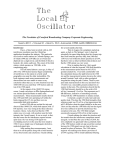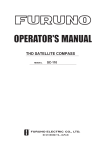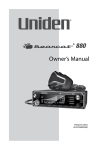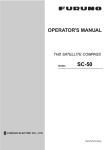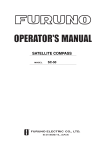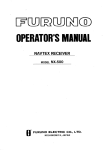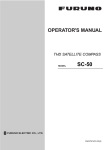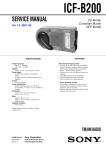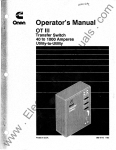Download Furuno SC-50/110 User's Manual
Transcript
SATELLITE COMPASS SC-50/110 The paper used in this manual is elemental chlorine free. FURUNO Authorized Distributor/Dealer 9-52 Ashihara-cho, Nishinomiya 662-8580, JAPAN Telephone : 0798-65-2111 Fax 0798-65-4200 : All rights reserved. Printed in Japan Pub. No. SME-72510-A ( KAOK ) SC-50 FIRST EDITION : NOV. 2005 *00015891300* *00015891300* *00015891300* *SME72510A00* *SME72510A00* *SME72510A00* Contents 1. Overview ...................................................................................... 1 2. Maintenance Menu ....................................................................... 2 1) MONITOR display ..............................................................................2 2) COMPASS display .............................................................................3 3) R MONITOR display ..........................................................................3 4) R-CALIB display ................................................................................4 5) RATE ERR display ............................................................................5 6) OUTPUT display ................................................................................5 7) ALARM display ..................................................................................6 8) ANALOG display ................................................................................6 9) ANT MONI display .............................................................................6 10) MESSAGE display ...........................................................................8 11) REC MONI menu .............................................................................8 3. Replacement of Battery ................................................................ 9 4. Reading Program Number............................................................ 9 5. Program Upgrade ......................................................................... 10 1) MAIN board .......................................................................................10 2) CPU board .........................................................................................11 6. Maintenance ................................................................................. 12 6.1 Adjustment .......................................................................................12 6.2 Line voltage check ............................................................................12 6.3 Jumper setting....................................................................................12 6.4 LED ..................................................................................................12 7. Location of Parts........................................................................... 13 Appendix 1 Protection of ICs in Data Output Circuit ......................... 15 Appendix 2 Modification on Data Output Circuit ............................... 20 Exploded View (Parts List) Radome Antanna, C7251-E01 .................................................................D-1 Processor Unit, C7251-E02 ....................................................................D-2 Schematic Diagrams Interconnection Diagram, C7251-C01 ....................................................S-1 Processor Unit (SC-510), C7251-K01 ....................................................S-2 POWER Board (20P8181, 1/2), C7251-K02 ..........................................S-3 POWER Board (20P8181, 2/2), C7251-K03 ..........................................S-4 1. Overview The satellite compass, SC-50/110 calculates the heading by using the carrier signal of the GPS satellite signals. The system also calculates the heading with three rate sensors. When the satellite signal is blocked, the system outputs the heading data based on the rate sensor signal for a maximum of 5 minutes. The system always compares GPS heading with rate sensor heading. If the difference between two exceeds the preset value, an alarm is generated. The system needs about 15 minutes for settling time at GPS cold start: 12 minutes for cold start and 3 minutes for settling time. GPS Heading Calculated heading data Rate sensor Heading Fig.1 Table below compares SC-50/110 to SC-60/120. Number of output port Output connector Processor unit Factory-default setting SC-50/110 Heading and NAV (IEC/AD-10): 5, Interval and baud rate selectable Heading (AD-10): 1 Pitch/Roll analog: 1 Terminal board W: 300, B: 200, H: 60 Wall (Bulkhead) mount SC-60/120 Heading (IEC/AD-10): 3 NAV: 1 (1 sec/4800 bps) Waterproof connector W: 335, B: 265, H: 103 Floor mount Output of Heading Data Heading data is output from HDG OUT ports. Either IEC or AD-10 heading data is output from HDG OUT 1 to HDG OUT 5 ports according to menu setting. OUTPUT 6 port outputs only AD-10 format heading data. When the port is selected for IEC output, two receivers are connected to the same port: #1(Data-H) and #2 (Data-C), and #3 (Data-H) and #4(Data-C). Thus, when HDG OUT ports 1 to 5 are used for IEC ports, 10 receivers can be connected to the system. Not only heading data but also NAV data is output from IEC port. Difference between 20P8178A and 20P8178B The MAIN board, 20P8178A is for SC-50 and 20P8178B for SC-110. The board carries a label “A” or “B.” The difference between A and B is software, but the program number is the same on top of the program ROM. 1 2. Maintenance Menu The system provides TEC menu or Maintenance menu for servicing. To show TEC menu, press and hold down MENU and ENT keys simultaneously until the menu appears after three beeps. It takes about 8 seconds to hear the third beep. Release the finger from MENU key, and then ENT key. If you release the finger from ENT key first, Main menu appears. This procedure is the same as SC-60/120. TEC MENU HDG SETUP MONITOR COMPASS R MONITOR R-CALIB RATE ERR OUTPUT ALARMS ANALOG ANT MONI MESSAGE REC MONI Fig. 2 TEC (Maintenance) menu 1) MONITOR display Figure 2 shows MONITOR menu. MONITOR YAW ROL PIT SC-OUT: 182.8 +0.1 +0.0 GPS: 182.8 +0.2 +0.1 ANG-V: -1.8 +1.1 +1.7 R-OFF: -204 0 CAL 0 0 CK-FLG 0 00 0 Fig.3 MONITOR menu SC-OUT: Output of the satellite compass (degree) GPS: Values calculated by using GPS signal (degree) ANG-V : Angular velocities of rate sensors (degree/sec) R-OFF: Offset values of rate sensors. CAL (Calculation): 0 when heading is calculated normally. (Base lines 1 and 2) CK-FLG (Check Flag): Number of detected error flag (0 normally). The system works normally even with a small number. 2 2) COMPASS display MASK-EL is used to set a minimum elevation angle of the satellite. The satellite of which elevation angle is lower than MASK-EL is not used for heading calculation. Default: 5 degrees. DO NOT change GPS DELAY, TIME CONST, SDEV-S, SDEV-C, and CHK NEW SV. COMPASS MASK-EL : 05° GPS DELAY : 0.220 SEC TIME CONST : 01 SEC SDEV-S : 0.0016 SDEV-C : 0.0069 CHK NEW SV : 0.20 Fig.4 COMPASS display 3) R MONITOR display “Rate sensor Monitor” display shows rate sensor errors as below. WA SHIFT: Shows the difference between GPS and rate sensor. DIFF RET: Shows an error if detected; 0: no error and 1: error. WA SA: Compares succeeding two Heading (GPS + Rate sensor) outputs. R MONITOR 18:52:49 1 normally YAW ROL PIT WA SHIFT +0.0º +0.0º +0.0º DIFF RET 0 0 B HEALTH 1 RATE SET 0000 WA SA 0 Shows difference between GPS and rate sensor. Shows an error. 1: error, 0: no error Factory use 0.0 00 Fig.5 R MONITOR display 3 Factory use 4) R-CALIB display R-CALIB (Rate sensor Calibration) is used to enter the calibration value of the rate sensor at factory. It is not necessary to change this value when the rate sensor is replaced with new one. However, the value on top of the original sensor is written on top of the replacement sensor for future service. R-CALIB S1 : +0.0% S2 : +0.0% S3 : +0.0% Fig.6 S2 (Roll*) S3 (Yaw*) S1 (Pitch*) *: Default Fig. 7 Rate sensors in Processor Unit 4 5) RATE ERR display This menu sets the level to trigger the heading error alarms; NO HEADING OUTPUT and RATE ERROR. The system compares the output of the angular rate sensor with one obtained by the GPS signal. In the following example, an error is detected when the difference is 2.0º or more. An alarm is generated according to SHIFT CONT setting. In the example below, an alarm is generated when Roll sensor has four consecutive errors. YAW LIMIT: Used to detect Yaw output error. Successive two yaw data (GPS + Rate sensor) is compared. In the example below, an alarm is generated when the difference is 1.00º or more. RATE ERR Yaw data error alarm level WA SHIFT YAW : 2.0º WA SHIFT ROL : 2.0º WA SHIFT PIT : 2.0º YAW LIMIT : 1.00º SHIFT CNT YAW :0 SHIFT CNT ROL :3 SHIFT CNT PIT :3 Threshold level for rate sensor error Number of consecutive errors (For example, an error message appears with three consecutive ROL errors.) Fig. 8 Rate error display When the rate sensor error appears after the installation, first check that the rate sensor is mounted and the installation menu is set correctly. If yes, increase the SHIFT CNT only 1. For example, if RATE ERROR! (YAW) is displayed, change SHIFT CNT YAW from 0 to 1. Never change the setting of WA SHIFT and YAW LIMIT. 6) OUTPUT display DO NOT change the setting in this menu, except for HDM. R&D engineers use this menu for investigation. HDM is changed to TRUE if necessary. OUTPUT M2 DATA : OFF GPS DATA : OFF LOG SENTENCE? HDM : MAG WAAS : OFF PITCH ROLL : ABSOLUTE Fig. 9 5 7) ALARM display This menu sets the ALARM port signal. When ALARM MODE is set to “STOP,” the alarm signal is not sent out after acknowledgement. When selected “Continue,” the system continues to output the alarm signal. ALARMS ALARM MODE : STOP BUZZER FREQ : 2.075 kHz Fig. 10 8) ANALOG display This menu is used to test and compensate the motion sensor output signal. Set the desired angle on the ANGLE line and the set angle data is output from “ROLL” and “PITCH” ports. If necessary, enter the Offset value (digital value). ANALOG ANGLE : +00º ROLL OFFSET : +000D PITCH OFFSET : +000D Fig. 11 9) ANT MONI display Figure 12 shows an example of Antenna Monitor display. Multipath Index for the baseline between antenna 1 and antenna 3 1.01 BOW Multipath Index for the baseline between antenna 1 and antenna 2 0.91 01 02 12 03 1 04 2 11 05 07 Circular graph 9 4 8 08 09 10 5 7 Elapsed time 06 3 10 6 11 12 95:55 11 Fig.12 ANT MONI display 6 Bar graph showing the tracking error rate. The longer the black bar, the higher the error rate. The display consists of four indications; a circular graph which shows direction where the tracking error rate is the highest, a bar graph which shows tracking error rates in 12 directions, mutlipath indexes, and elapsed time. Circular graph: Shows the relation of 12 directions to the bow. The direction of the highest tracking error rate and its opposite direction are painted. Note that the sectors are painted even when no heading loss problem occurs. Bar graph: Shows tracking error rate in 12 directions. The bar number corresponds to the sector number. The longer the bar, the more the error occurs. The blockage of the satellite signal by surrounding may cause the tracking error. Note that the sector opposite to the obstacle may have the longest bar. Multipath indexes: Shows the effect of the multipath reflection. It is around 1.0 normally. If it is 1.5 or above, the antenna must be relocated, because the system is affected by the multipath reflection. The left figure is the index for the baseline 2 (antennas 1 and 3) and the right one for the baseline 1 (antennas 1 and 2). Elapsed time: Shows how long the data is collected. The timer starts at first power up after installation and counts up to 99 hours and 59 minutes (99:59). No measurements are made after 99 hours 59 minutes. Allow the system 12 hours or more to collect the data in various satellite configurations because the satellite configuration has little change within 12 hours. In the example of Figure 13, the tracking error occurs at the highest rate in 10 o’clock direction. The satellite signal is blocked by an obstacle located at 10 o’clock on board a ship. Center of circular graph Obstacle blocking satellite signal SC-50/110 antennas Fig.13 7 Sector opposite to the obstacle (Reflected signal from the obstacle may cause the tracking error.) 10) MESSAGE display Error messages appear in the display. If RATE ERROR! appears, first check Installation Setup menu for correct setting: “Mounting” method and “Direction.” MESSAGES • NO HEADING OUTPUT ! • HEADING ERROR ! • RATE ERROR ! (YAW) Fig.14 Error Message display 11) REC MONI menu The REC MONI display, Figure 15 shows whether the system works normally or not. The GPS receiver having the least tracking error rate reads 1.0. The error rate of other receivers is between 0.7 and 0.9 normally. In the example of Figure 16, the receivers GPS2 and GPS3 have 20 % and 10% higher error rate than GPS1 respectively. If the error rate is 0.5 or less, the receiver and/or the antenna may be defective. The number of the satellite being used for heading calculation is displayed at the right-hand side below CAL, and the number of the satellite being tracked below ALL. The system requires 4 or more satellites for heading calculation. The timer is reset by selecting “CNT Reset?”. REC MONITOR CAL ALL GPS1 1.0 GPS2 0.8 9/10 GPS3 0.9 9/9 9/10 CAL: Number of satellite being used for heading calculation ALL: Number of satellite being tracked CNT RESET ? V_MASK : 05º Elapsed time from power-on 99:59 Tracking error rate Fig.15 REC MONI display V-MASK is used to set the angle where the satellite signal is not received for ANT MONI display. For example, if 15 degrees is entered, the satellite signal between 0º and 15º is not used to create ANT MONI display. 8 3. Replacement of Battery The processor unit has a battery which backs up the RAM contents when the power is removed. When the voltage of the battery drops to 2.5 V, the message “BATTERY!” appears on the screen. To check the message, press [MENU] key and choose “MESSAGE.” The lifetime of the batteries is 3 to 5 years. CAUTION! Take care to avoid short-circuit of the battery. This could create a burn or fire hazard. Do not dispose of the battery in a fire or an incinerator; this may cause an explosion. When the message BATTERY! appears, save the contents of the RAM onto the flash memory temporarily as soon as possible (within about 24 hours). If the data is transferred to the flash memory, they are not erased during the replacement. Parts Name Lithium Battery Type Code No. CR2450-F2ST2L 000-144-941 To transfer the memory; 1. Choose EXCHANGE BATTERY? in the SYS SETUP menu. 2. Follow the instructions on the menu. Use [ENT] key to proceed the step. To replace the battery; 3. Loosen four screws and remove the front cover. 4. Remove the MAIN board by loosening screws fixing the board to the chassis. 5. Unsolder the battery. 6. Solder new battery. 4. Reading Program Number To display the program number list; 1. Press [MENU] key. SOFTWARE VERSION 2. Choose SOFT VER. and press [ENT] key. The following list appears. DISPLAY 205-1342-01.01 PROCESS 205-1341-01.02 GPS1 4850263003 GPS2 4850263003 GPS3 4850263003 3. Press [DISP] to close the menu. Fig.16 SOFTWARE VERSION menu 9 5. Program Upgrade The three programs are used for the SC-50/110. Two programs are used in the processor unit and one program is in the display unit. The program numbers are tabulated below. Note that the program number of SC-50 is the same as SC-110, but they are different. The program for SC-50 cannot be overwritten by the one for SC-110 in the field and vise versa. (As of February 2005) Unit Board Processor unit Display unit Program No. How to update MAIN board 205-1341-01.02 By using a PC GPS receiver 4850263003 By replacing GPS core CPU board 205-1342-01.01 By using a PC The following describes how to update the programs stored on the MAIN and CPU boards. 1) MAIN board (Processor unit) To upgrade the program on the MAIN board; 1. Connect the serial port of the PC to J15 (D-sub) on MAIN board PC (Serial port) #3 #2 #6 #4 #6 #7 #8 SC-50/110 (J15) #2 RXD #3 TXD #5 GND 2. Turn on the PC. Do not as yet turn on the SC-50/110. 3. Click the SCUP.bat file in the SC-50/110 program file. 4. Turn on the SC-50/110 after the message “TARGET POWER ON” on the PC screen. 5. “NOW LOADING” appears on the SC-50/110 display unit, while “Now Erasing”, and “xxx percent completed” appear during program upgrade on the PC screen. 6. The program upgrade is completed with the message “Finish Version up.ted” on the PC screen. (About 3 minutes 30 seconds) The SC-50/110 displays the Heading display. 7. Turn off the SC-50/110 and turn it on again. 8. Confirm the program number through the SOFT VER. menu. 10 2) CPU board (Display unit) To upgrade the program on the CPU board; 1. Connect the serial port of the PC to J15 on MAIN board in the processor unit. 2. Turn on the PC. Do not as yet turn on the SC-50/110. 3. Click the SCUP.bat file in the SC-50/110 program file. 4. Turn on the SC-50/110 after the message “TARGET POWER ON” on the PC screen. 5. “NOW LOADING” appears on the SC-50/110 display unit, while “Now Erasing,” and “xxx percent completed” appear during program upgrade on the PC screen,. 6. The program upgrade is completed with the message “Finish Version up.ted” on the PC screen. (About 3 minutes 30 seconds) The SC-50/110 displays the Heading display. 7. Turn off the SC-50/110 and turn it on again. 8. Confirm the program number through the SOFT VER. menu. 11 6. Maintenance 6.1 Adjustment 1) PWR board Switching regulator frequency is adjusted on PWR board, 20P8181 as below. Test Point GND Rating Adjuster TP2 TP1 120.0 kHz ± 10 kHz VR79 TP5 TP3 120.0 kHz ± 10 kHz VR80 2) MAIN board Vcc-c supply voltage to Rate sensor is adjusted by VR96 on MAIN board, 20P8178. Test Point GND Rating Adjuster #1 of J20 #2 of J20 5.0 V (Vcc-c) VR96 6.2 Line voltage check Line voltages are checked at J3 on the MAIN board. Line voltage Test Points on MAIN board Rating 3.3 V #4 (+) and #5(-) of J3 3.15 to 3.45 V 5.1 V (5 V) #1 (+) and #5(-) of J3 4.94 to 5.46 V 6.5 V #8 (+) and #5(-) of J3 6.2 to 6.8 V 13.5 V (15 V) #7 (+) and #5(-) of J3 12.5 to 14.4 V 6.3 Jumper setting Jumper JP1 on the MAIN board is used at factory to set the MAIN board to A or B version. 6.4 LED CR3 on the MAIN board blinks when the CPU is running. 12 7. Location of Parts Rate Sensor (Default: Roll) Rate Sensor (Default: Yaw) Rate Sensor (Default: Pitch) PWR Board (20P8181) GPS Receivers (1, 2, 3 from Top) Main Board (20P8178) Fig. 17 Processor Unit with cover removed F1, 3A TP2 TP1 TP4 Fig.18 PWR Board, 20P8181 TP3 TP4 VR80 VR79 (not shown) 13 Log/Alarm Roll (above) Pitch Beacon Ext Data out 6 Data In (AD-10) Data out 1 to 5 (from right, IEC or AD-10 Heading data) J3 J15 for system update R96 CR3 (CPU), Blinking No short bar (for R&D) TP1 JP1 BT1 (CR2450-F2ST2L) Fig.19 MAIN Board, 20P8178 14 J 20 J19 J18 Appendix 1 Protection of ICs in Data Output Circuit Appendix 1 describes how to prevent ICs in the data output circuit temporarily. Refer to Appendix 2 for permanent remedy. Symptom U1, U2, and U3 in the heading output circuit are damaged. Cause Ground potential difference - The cable shield, or a signal return path between the circuit grounds of the equipment is not connected securely. The shield is connected to the unit through the cable clamp on SC-50/110, while the connector pin is used on SC-60/120. Remedy At installation: Carry out 1) to 4). When the symptom occurs: Carry out 1) to 5). 1) Solder a grounding cable to the cable shield and ground it through the screw fixing the MAIN board. See the attached sheet. 2) Ground SC-50/110 processor unit securely. 3) Connect the cable shield at the end of the interconnected unit as below. IEC61162-1 and AD-10 (photo coupler): Frame Ground (FG) IEC61162-2 (RS422/485): Signal Ground (SG) 4) Connect the interconnected unit securely 5) Add zener diodes in the heading output circuit to protect the IC from being damaged by surge. J2 to J7 Zener diodes added Type: RD9.1EB3-T4 C/N: 000-138-700 Fig.1 Zener diodes added in data output circuit Factory-modified sets SC-110 (SC1101): 4404-0329 and after SC-50 (SC501): 4403-2224 and after 15 1. Fabrication of Signal Cable The signal cable is fabricated as below. DO NOT hold back the cable shield over the armor. The installation manual will be revised. 80 Armor 70 Twist and cut. FV1.25-M3 Grounding wire Solder 40 Remove coat for clamping. 80 Armor Twist and cut. 70 FV1.25-M3 Grounding wire Solder 40 Vinyl tape Fig. 2 16 Remove coat for clamping. 2. Grounding Cable Shield Ground the cable shield or grounding wire to the chassis by using the screw fixing the MAIN board, 20P8178 to the chassis. Fig. 3 Connection of grounding wire 17 3. Adding Zener Diodes Zener diodes are added to the data output circuit as below. 1. Fabricate the diode as shown in the figure below. Type: RD9.1EB3-T4 4 mm C/N: 000-138-700 4 mm 2 mm 4 mm 4 mm Fig. 4 Fabrication of zener diode 2. Remove the coat and solder the diode. See Fig. 5. 3. Do the same for other pins and other ports. J2 J3 J4 Remove the coat and then solder the anode. Do the same for other diodes. Fig. 5 Zener diodes on MAIN board, soldering side 18 Reference) The following waveforms show the effectiveness of the modification. With the SC-50/110 processor unit being not modified, a spike noise is observed at the output terminal on SC-50/110 when the interconnected unit is turned on. (Fig. 6) After modification, the noise is not observed. (Fig. 7) Before modification Condition: SC-50 switched off Measuring points: CH1: TD1-A (pin #1) on DATA 5 port CH2: TD1-B (pin #2) on DATA 5 port Ground lead: SG (=FG) on SC-50 Fig. 6 After modification Fig. 7 19 Appendix 2 Modification on Data Output Circuit Appendix 1 describes the tentative remedy to prevent U1, U2, and U3 in the heading output circuit from being damaged. Following modification (Table below) is the permanent remedy. The connector is changed from 4 pins to 5 pins for the connection of cable shield. When installing the unit having the current MAIN board (-55); 1) Connect the cable shield to pin #5 of DATA OUT port. 2) Ground the frame of SC-50/110 securely. 3) Connect the other end of the cable shield to FG when data is IEC61162-1/AD-10 (photo coupler), or SG when data is IEC61162-2 (RS422/485). 4) Ground the frame of the unit connected to SC-50/110 securely. Before modification U1, U2, and U3 MAX3043EUE-T CR7 to CR30 RD9.1EB3-T4 Connectors (J2 to J7), 231-334/001-000, DATA1 to DATA 6 connector Plugs (P2 to P7), 231-304/026-FUR, DATA1 to DATA 6 4-pin plug MAIN board 20P8178-33 After modification SN75ALS172DE 4-pin 1SS226-TE85LF 231-335/001-000, 5-pin connector 231-305/026-FUR, 5-pin plug 20P8178-55 J2 to J7 (DATA OUT port) DATA-H/TD-A DATA-C/TD-B SHIFT-H/TD’-A SHIFT-C/TD’-B FG Fig.1 Connection on DATA OUT port Factory-modified sets SC-50 (SC501): 4403-2637 and after SC-110 (SC1101): 4404-0360 and after 20






























